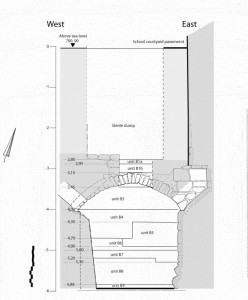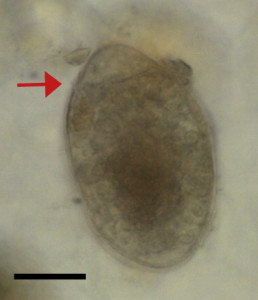
In 1996 the team carried out excavations of a cesspool in the courtyard of a Spanish school near to the Church of the Holy Sepulchre (suggested to be the place of Christ’s crucifixion, burial and resurrection and an ancient pilgrimage site) in the Christian quarter of Jerusalem.
During the excavation they found a piece of charcoal and were able to reliably radiocarbon date the tree to between 1304 and 1413 AD, suggesting the cesspool itself was in use during the second half of the 15th century and the beginning of the 16th century.
On excavation they found “12 lightly mineralised coprolites” (preserved poo), fragments of Italian pottery and a number of chamber pots which confirmed the use of the structure as a cesspool.
The mineralised stools, as well as some of the sediment from the latrine, were examined for the presence of parasites. Samples of the 12 coprolites and the sediment were broken up in solution and passed through microsieves. Parasite eggs were identified to genera or species based on shape, colour and distinguishing features using digital light microscopy while the presence of the dysentery causing protozoa species, Giardia duodenalis, Entamoeba histolytica and Cryptosporidium parvum was assessed by species specific ELISAs.
The eggs of Trichuris trichura (whipworm) and Ascaris lumbricoides (roundworm) were common and found in all coprolite samples and the sediment sample. The study suggests that it is likely these species had become endemic to the area long before the medieval period as they have been found in Iron Age, Roman and Byzantine contexts and are believed to have accompanied the evolution of humans in Africa. These parasites are spread by the faecal-oral route and are believed to have become more prevalent in Europe and the Middle East with the development of agriculture (and the corresponding use of human faeces as a fertiliser) and the aggregation of people in towns with limited sanitation.
Eggs of Taenia sp. (tapeworm) were also found in two coprolites. Although the exact species could not be determined, T. solium (pork tapeworms), T.

saginata (beef tapeworm) and T. asiatica (asiatic tapeworm) are all possible candidates. As their name suggests their intermediate hosts are cattle and pigs with humans becoming infected via the ingestion of undercooked or raw meat and are also thought to be endemic to the region during the Medieval period. While Islam was the dominant religion at the time, excavations of the period suggest Christians were free to farm and eat pigs and given the location of the latrine in the Christian quarter of the city, it is possible the Taenia infections were derived from pigs.
While these findings were not surprising, other results were less expected and shed some light on the historical movements of people between Europe and the Middle East.
Eggs of a fish tapeworm, Diphyllobothrium sp., were found in one coprolite. This parasite is acquired by ingesting undercooked or raw fish and is thought to have been very rare or non-endemic during the medieval period in the Middle East. Fish were rarely eaten in Jerusalem and were always cooked which would have killed the parasite, therefore it is unlikely that it was a locally acquired infection. However, this parasite was common in northern Europe during medieval times, suggesting someone from that region must have visited the area, used the latrine and deposited the eggs.
“The presence of the fish tapeworm – which can reach ten metres long in humans, and coils around inside the intestine – combined with the fragments of pottery made in Italy, most likely indicates that travellers from northern Europe used this latrine during a visit to Jerusalem,” said Dr Mitchell.
The dysentery causing protozoa, Entamoeba histolytica and Giardia duodenalis, were each confirmed in a coprolite and the sediment respectively. The earliest known cases of these pathogens were identified in Europe and it is also thought that E. histolytica evolved in Europe, further supporting the argument that visitors from the region brought these parasites with them as opposed to acquiring them locally.

Due to its geographic location, Jerusalem has long been an important hub for trade and travel between Europe, Africa and Asia. It was then, as it is now, also a mixing pot of different religions and a holy site within Judaism, Christianity and Islam. Not only were merchants drawn to the area for trade with other regions but large numbers of pilgrims also visited which had implications for the spread of parasites and disease across the region.
This cesspool was not simply a hole in the ground but instead was a more permanent structure with a roof and stone walls. As an explanation for the results, the authors suggest the property may have belonged to a merchant from Jerusalem who travelled to Europe for trade and returned with a few extras-including some gut parasites and an Italian pot! Another explanation is that the cesspool belonged to a hostel of some kind that would have hosted pilgrims or merchants travelling to and from Europe or other regions.
“This research highlights how we can use preserved parasite eggs in ancient toilets to spot past migrations and the spread of ancient diseases. Jerusalem’s importance to Christians in medieval Europe made it a key destination for both pilgrimage and trade. We can see these travellers took unexpected guests along with them.” said Dr Mitchell.
The study is a neat example of how paleoparasitology may be used to reconstruct the movements of people in the past and shed light on the historical spread of parasites and diseases.

3 Comments